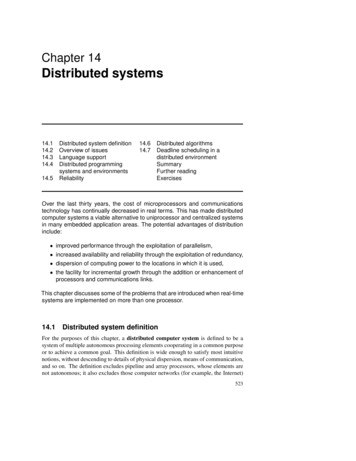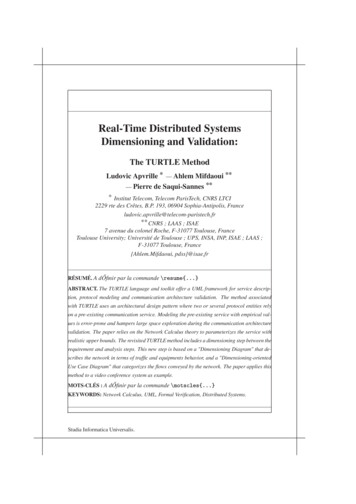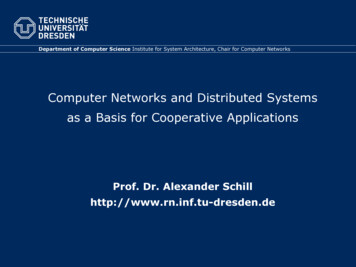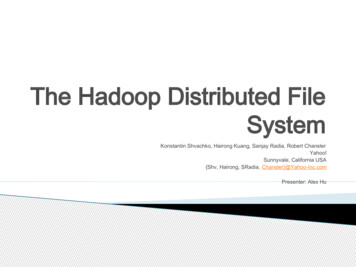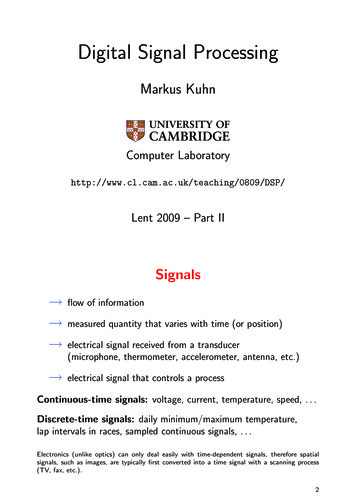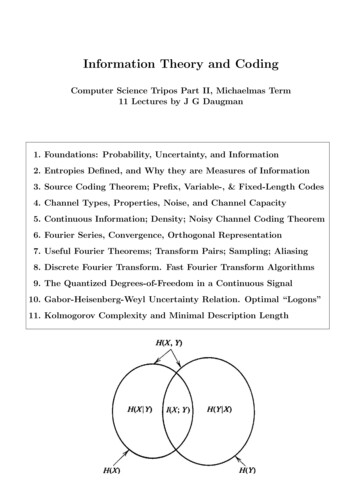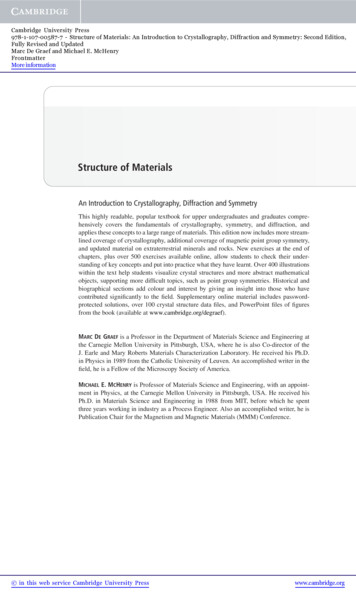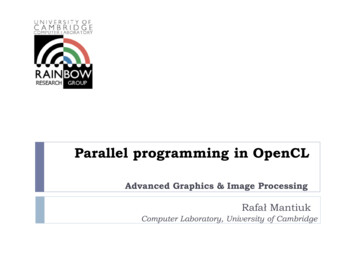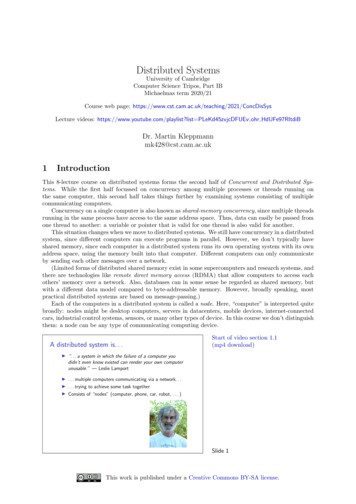
Transcription
Distributed SystemsUniversity of CambridgeComputer Science Tripos, Part IBMichaelmas term 2020/21Course web page: Lecture videos: https://www.youtube.com/playlist?list PLeKd45zvjcDFUEv ohr HdUFe97RItdiBDr. Martin Kleppmannmk428@cst.cam.ac.uk1IntroductionThis 8-lecture course on distributed systems forms the second half of Concurrent and Distributed Systems. While the first half focussed on concurrency among multiple processes or threads running onthe same computer, this second half takes things further by examining systems consisting of multiplecommunicating computers.Concurrency on a single computer is also known as shared-memory concurrency, since multiple threadsrunning in the same process have access to the same address space. Thus, data can easily be passed fromone thread to another: a variable or pointer that is valid for one thread is also valid for another.This situation changes when we move to distributed systems. We still have concurrency in a distributedsystem, since different computers can execute programs in parallel. However, we don’t typically haveshared memory, since each computer in a distributed system runs its own operating system with its ownaddress space, using the memory built into that computer. Different computers can only communicateby sending each other messages over a network.(Limited forms of distributed shared memory exist in some supercomputers and research systems, andthere are technologies like remote direct memory access (RDMA) that allow computers to access eachothers’ memory over a network. Also, databases can in some sense be regarded as shared memory, butwith a different data model compared to byte-addressable memory. However, broadly speaking, mostpractical distributed systems are based on message-passing.)Each of the computers in a distributed system is called a node. Here, “computer” is interpreted quitebroadly: nodes might be desktop computers, servers in datacenters, mobile devices, internet-connectedcars, industrial control systems, sensors, or many other types of device. In this course we don’t distinguishthem: a node can be any type of communicating computing device.A distributed system is. . .Start of video section 1.1(mp4 download)I “. . . a system in which the failure of a computer youdidn’t even know existed can render your own computerunusable.” — Leslie LamportI . . . multiple computers communicating via a network. . .I . . . trying to achieve some task togetherI Consists of “nodes” (computer, phone, car, robot, . . . )Slide 1This work is published under a Creative Commons BY-SA license.
1.1About distributed systemsThese notes and the lecture recordings should be self-contained, but if you would like to read up onfurther detail, there are several suggested textbooks: Maarten van Steen and Andrew S. Tanenbaum. Distributed Systems. ISBN 978-1543057386. Freedownload from s/ds3/ (third edition, 2017).This book gives a broad overview over a large range of distributed systems topics, with lots ofexamples from practical systems. Christian Cachin, Rachid Guerraoui, and Luı́s Rodrigues. Introduction to Reliable and SecureDistributed Programming. Second edition, Springer, 2011. ISBN 978-3-642-15259-7.Ebook download for Cambridge users: 5260-3then click Log in via Shibboleth type University of Cambridge log in with Raven.This book is more advanced, going into depth on several important distributed algorithms, andproving their correctness. Recommended if you want to explore the theory in greater depth thanthis course covers. Martin Kleppmann. Designing Data-Intensive Applications, O’Reilly, 2017. ISBN 978-1449373320.This book goes more in the direction of databases, but also covers a number of distributed systemstopics. It is designed for software engineers in industry working with distributed databases. Jean Bacon and Tim Harris. Operating Systems: Concurrent and Distributed Software Design.Addison-Wesley, 2003. ISBN 978-0321117892.This book provides a link to the concurrent systems half of the course, and to operating systemstopics.Where appropriate, these lecture notes also contain references to research papers and other usefulbackground reading (these are given in square brackets, and the details appear at the end of this document). However, only material covered in the lecture notes and videos is examinable.Recommended readingI van Steen & Tanenbaum.“Distributed Systems”(any ed), free ebook availableI Cachin, Guerraoui & Rodrigues.“Introduction to Reliable and Secure DistributedProgramming” (2nd ed), Springer 2011I Kleppmann.“Designing Data-Intensive Applications”,O’Reilly 2017I Bacon & Harris.“Operating Systems: Concurrent and DistributedSoftware Design”, Addison-Wesley 2003Slide 2The syllabus, slides, and lecture notes for this course have been substantially revised for 2020/21.This means that new mistakes may have crept in. If you notice anything wrong, or if anything is unclear,please let me know by email (mk428@cst.cam.ac.uk)!As for other courses, past exam questions are available at /t-ConcurrentandDistributedSystems.html. Because of syllabus changes, the following past examquestions are no longer applicable: 2018 P5 Q8; 2015 P5 Q8; 2014 P5 Q9 (a); 2013 P5 Q9; 2011 P5 Q8 (b).These notes also contain exercises, which are suggested material for discussion in supervisions. Solution notes for supervisors are available from the course web page.This course is related to several other courses in the tripos, as shown on Slide 3.2
Relationships with other coursesI Concurrent Systems – Part IB(every distributed system is also concurrent)I Operating Systems – Part IA(inter-process communication, scheduling)I Databases – Part IA(many modern databases are distributed)I Computer Networking – Part IB Lent term(distributed systems involve network communication)I Further Java – Part IB Michaelmas(distributed programming practical exercises)I Security – Part IB Easter term(network protocols with encryption & authentication)I Cloud Computing – Part II(distributed systems for processing large amounts of data)Slide 3There are a number of reasons for creating distributed systems. Some applications are intrinsicallydistributed : if you want to send a message from your phone to your friend’s phone, that operationinevitably requires those phones to communicate via some kind of network.Some distributed systems do things that in principle a single computer could do, but they do itmore reliably. A single computer can fail and might need to be rebooted from time to time, but if youare using multiple nodes, then one node can continue serving users while another node is rebooting.Thus, a distributed system has the potential to be more reliable than a single computer, at least if it iswell-designed (somewhat contradicting Lamport’s quote on Slide 1)!Another reason for distribution is for better performance: if a service has users all over the world,and they all have to access a single node, then either the users in the UK or the users in New Zealandare going to find it slow (or both). By placing nodes in multiple locations around the world, we can getaround the slowness of the speed of light by routing each user to a nearby node.Finally, some large-scale data processing or computing tasks are simply too big to perform on a singlecomputer, or would be intolerably slow. For example, the Large Hadron Collider at CERN is supportedby a worldwide computing infrastructure with 1 million CPU cores for data analysis, and 1 exabyte (1018bytes) of storage! See https://wlcg-public.web.cern.ch/.Why make a system distributed?I It’s inherently distributed:e.g. sending a message from your mobile phone to yourfriend’s phoneI For better reliability:even if one node fails, the system as a whole keepsfunctioningI For better performance:get data from a nearby node rather than one halfwayround the worldI To solve bigger problems:e.g. huge amounts of data, can’t fit on one machineSlide 4However, there are also downsides to distributed systems, because things can go wrong, and thesystem needs to deal with such faults. The network may fail, leaving the nodes unable to communicate.3
Slide 5Another thing that can go wrong is that a node may crash, or run much slower than usual, ormisbehave in some other way (perhaps due to a software bug or a hardware failure). If we want one nodeto take over when another node crashes, we need to detect that a crash has happened; as we shall see,even that is not straightforward. Network failures and node failures can happen at any moment, withoutwarning.In a single computer, if one component fails (e.g. one of the RAM modules develops a fault), wenormally don’t expect the computer to continue working nevertheless: it will probably just crash. Softwaredoes not need to be written in a way that explicitly deals with faulty RAM. However, in a distributedsystem we often do want to tolerate some parts of the system being broken, and for the rest to continueworking. For example, if one node has crashed (a partial failure), the remaining nodes may still be ableto continue providing the service.If one component of a system stops working, we call that a fault, and many distributed systems striveto provide fault tolerance: that is, the system as a whole continues functioning despite the fault. Dealingwith faults is what makes distributed computing fundamentally different, and often harder, comparedto programming a single computer. Some distributed system engineers believe that if you can solve aproblem on a single computer, it is basically easy! Though, in fairness to our colleagues in other areas ofcomputer science, this is probably not true.Why NOT make a system distributed?The trouble with distributed systems:I Communication may fail (and we might not even know ithas failed).I Processes may crash (and we might not know).I All of this may happen nondeterministically.Fault tolerance: we want the system as a whole to continueworking, even when some parts are faulty.This is hard.Writing a program to run on a single computer iscomparatively easy?!Slide 61.2Distributed systems and computer networkingWhen studying distributed systems, we usually work with a high-level abstraction of the hardware.4
Distributed Systems and Computer NetworkingStart of video section 1.2(mp4 download)We use a simple abstraction of communication:node imessage mnode jReality is much more complex:I Various network operators:eduroam, home DSL, cellular data, coffee shop wifi,submarine cable, satellite. . .I Physical communication:electric current, radio waves, laser, hard drives in a van. . .Slide 7In this course, we just assume that there is some way for one node to send a message to another node.We don’t particularly care how that message is physically represented or encoded – the network protocols,informally known as the bytes on the wire – because the basic principle of sending and receiving messagesremains the same, even as particular networking technologies come and go. The “wire” may actually beradio waves, lasers, a USB thumb drive in someone’s pocket, or even hard drives in a van.Hard drives in a g/using-device.htmlHigh latency, high bandwidth!Slide 8Indeed, if you want to send a very large message (think tens of terabytes), it would be slow to sendthat data over the Internet, and it is in fact faster to write that data to a bunch of hard drives, load theminto a van, and to drive them to their destination. But from a distributed systems point of view, themethod of delivering the message is not important: we only see an abstract communication channel witha certain latency (delay from the time a message is sent until it is received) and bandwidth (the volumeof data that can be transferred per unit time).The Computer Networking course in Lent term focusses on the network protocols that enable messagesto get to their destination. The study of distributed systems builds upon that facility, and instead focusseson how several nodes should coordinate in order to achieve some shared task. The design of distributedalgorithms is about deciding what messages to send, and how to process the messages when they arereceived.5
Latency and bandwidthLatency: time until message arrivesI In the same building/datacenter: 1 msI One continent to another: 100 msI Hard drives in a van: 1 dayBandwidth: data volume per unit timeI 3G cellular data: 1 Mbit/sI Home broadband: 10 Mbit/sI Hard drives in a van: 50 TB/box 1 Gbit/s(Very rough numbers, vary hugely in practice!)Slide 9The web is an example of a distributed system that you use every day.Slide 10Client-server example: the webTime flows from top to bottom.clientserver www.cst.cam.ac.ukGET /teaching/2021/ConhtE html !DOCTYPcDisSysml .Slide 11In the web there are two main types of nodes: servers host websites, and clients (web browsers)display them. When you load a web page, your web browser sends a HTTP request message to theappropriate server. On receiving that request, the web server sends a response message containing the6
page contents to the client that requested it. These messages are normally invisible, but we can captureand visualise the network traffic with a tool such as Charles (https://www.charlesproxy.com/), shown onSlide 12. The lecture video includes a demo of this software in action.request messageresponse messageSlide 12In a URL, the part between the // and the following / is the hostname of the server to which the clientis going to send the request (e.g. www.cst.cam.ac.uk), and the rest (e.g. /teaching/2021/ConcDisSys)is the path that the client asks for in its request message. Besides the path, the request also containssome extra information, such as the HTTP method (e.g. GET to load a page, or POST to submit a form),the version of the client software (the user-agent), and a list of file formats that the client understands(the accept header ). The response message contains the file that was requested, and an indicator of itsfile format (the content-type); in the case of a web page, this might be a HTML document, an image, avideo, a PDF document, or any other type of file.Since the requests and responses can be larger than we can fit in a single network packet, the HTTPprotocol runs on top of TCP, which breaks down a large chunk of data into a stream of small networkpackets (see Slide 13), and puts them back together again at the recipient. HTTP also allows multiplerequests and multiple responses to be sent over a single TCP connection. However, when looking at thisprotocol from a distributed systems point of view, this detail is not important: we treat the request asone message and the response as another message, regardless of the number of physical network packetsinvolved in transmitting them. This keeps things independent of the underlying networking technology.Slide 137
1.3Example: Remote Procedure Calls (RPC)Another example of an everyday distributed system is when you buy something online using a credit/debitcard. When you enter your card number in some online shop, that shop will send a payment request overthe Internet to a service that specialises in processing card payments.Start of video section 1.3(mp4 download)Client-server example: online paymentspayments serviceonline shopcharge 3.99 to credit card 1234. . .successSlide 14The payments service in turn communicates with a card network such as Visa or MasterCard, whichcommunicates with the bank that issued your card in order to take the payment.For the programmers who are implementing the online shop, the code for processing the paymentmay look something like the code on Slide 15.Remote Procedure Call (RPC) example// Online shop handling customer's card detailsCard card new Card();card.setCardNumber("1234 5678 8765 123");Result result paymentsService.processPayment(card,3.99, Currency.GBP);if (result.isSuccess()) {fulfilOrder();}Implementation of this function is on another node!Slide 15Calling the processPayment function looks like calling any other function, but in fact, what is happening behind the scenes is that the shop is sending a request to the payments service, waiting for aresponse, and then returning the response it received. The actual implementation of processPayment –the logic that communicates with the card network and the banks – does not exist in the code of theshop: it is part of the payments service, which is another program running on another node belonging toa different company.This type of interaction, where code on one node appears to call a function on another node, is calleda Remote Procedure Call (RPC). In Java, it is called Remote Method Invocation (RMI). The softwarethat implements RPC is called an RPC framework or middleware. (Not all middleware is based on RPC;there is also middleware that uses different communication models.)When an application wishes to call a function on another node, the RPC framework provides a stubin its place. The stub has the same type signature as the real function, but instead of executing thereal function, it encodes the function arguments in a message and sends that message to the remote8
node, asking for that function to be called. The process of encoding the function arguments is knownas marshalling. In the example on Slide 16, a JSON encoding is used for marshalling, but various otherformats are also used in practice.online shopRPC clientprocessPayment() stubmarshal argsRPC serverpayment servicem1unmarshal al resultmarshal resultfunction returns{"request": "processPayment","card": {"number": "1234567887654321","expiryDate": "10/2024","CVC": "123"},"amount": 3.99,"currency": "GBP"m1 {m2 "result": "success","id": "XP61hHw2Rvo"}}Slide 16The sending of the message from the RPC client to the RPC server may happen over HTTP (in whichcase this is also called a web service), or one of a range of different network protocols may be used. Onthe server side, the RPC framework unmarshals (decodes) the message and calls the desired functionwith the provided arguments. When the function returns, the same happens in reverse: the function’sreturn value is marshalled, sent as a message back to the client, unmarshalled by the client, and returnedby the stub. Thus, to the caller of the stub, it looks as if the function had executed locally.Remote Procedure Call (RPC)Ideally, RPC makes a call to a remote function look the sameas a local function call.“Location transparency”:system hides where a resource is located.In practice. . .I what if the service crashes during the function call?I what if a message is lost?I what if a message is delayed?I if something goes wrong, is it safe to retry?Slide 17Exercise 1. Networks and nodes might fail. What are the implications for code that calls another nodethrough RPC? How is RPC different from a local function call? Is location transparency achievable?Over the decades many variants of RPC have been developed, with the goal of making it easier toprogram distributed systems. This includes object-oriented middleware such as CORBA in the 1990s.However, the underlying distributed systems challenges have remained the same [Waldo et al., 1994].9
RPC historyIIIIIIIISunRPC/ONC RPC (1980s, basis for NFS)CORBA: object-oriented middleware, hot in the 1990sMicrosoft’s DCOM and Java RMI (similar to CORBA)SOAP/XML-RPC: RPC using XML and HTTP (1998)Thrift (Facebook, 2007)gRPC (Google, 2015)REST (often with JSON)Ajax in web browsersSlide 18Today, the most common form of RPC is implemented using JSON data sent over HTTP. A popularset of design principles for such HTTP-based APIs is known as representational state transfer or REST[Fielding, 2000], and APIs that adhere to these principles are called RESTful. These principles include: communication is stateless (each request is self-contained and independent from other requests), resources (objects that can be inspected and manipulated) are represented by URLs, and the state of a resource is updated by making a HTTP request with a standard method type, suchas POST or PUT, to the appropriate URL.The popularity of REST is due to the fact that JavaScript code running in a web browser can easilymake this type of HTTP request, as shown in Slide 19. In modern websites it is very common to useJavaScript to make HTTP requests to a server without reloading the whole page. This technique issometimes known as Ajax.RPC/REST in JavaScriptlet args {amount: 3.99, currency: 'GBP', /*.*/ };let request {method: 'POST',body:JSON.stringify(args),headers: {'Content-Type': yments', request).then((response) {if (response.ok) success(response.json());else failure(response.status); // server error}).catch((error) {failure(error); // network error});Slide 19The code on Slide 19 takes the arguments args, marshals them to JSON using JSON.stringify(),and then sends them to the URL https://example.com/payments using a HTTP POST request. Thereare three possible outcomes: either the server returns a status code indicating success (in which casewe unmarshal the response using response.json()), or the server returns a status code indicating anerror, or the request fails because no response was received from the server (most likely due to a networkinterruption). The code calls either the success() or the failure() function in each of these cases.Even though RESTful APIs and HTTP-based RPC originated on the web (where the client isJavaScript running in a web browser), they are now also commonly used with other types of client(e.g. mobile apps), or for server-to-server communication.10
RPC in enterprise systems“Service-oriented architecture” (SOA) / “microservices”:splitting a large software application into multiple services(on multiple nodes) that communicate via RPC.Different services implemented in different languages:I interoperability: datatype conversionsI Interface Definition Language (IDL):language-independent API specificationSlide 20Such server-to-server RPC is especially common in large enterprises, whose software systems are toolarge and complex to run in a single process on a single machine. To manage this complexity, the systemis broken down into multiple services, which are developed and administered by different teams andwhich may even be implemented in different programming languages. RPC frameworks facilitate thecommunication between these services.When different programming languages are used, the RPC framework needs to convert datatypessuch that the caller’s arguments are understood by the code being called, and likewise for the function’sreturn value. A typical solution is to use an Interface Definition Language (IDL) to provide languageindependent type signatures of the functions that are being made available over RPC. From the IDL,software developers can then automatically generate marshalling/unmarshalling code and RPC stubs forthe respective programming languages of each service and its clients. Slide 21 shows an example of theIDL used by gRPC, called Protocol Buffers. The details of the language are not important for this course.gRPC IDL examplemessage PaymentRequest {message Card {required string cardNumber 1;optional int32 expiryMonth 2;optional int32 expiryYear 3;optional int32 CVC 4;}enum Currency { GBP 1; USD 2; }required Cardcard 1;required int64amount 2;required Currency currency 3;}message PaymentStatus {required boolsuccess 1;optional string errorMessage 2;}service PaymentService {rpc ProcessPayment(PaymentRequest) returns (PaymentStatus) {}}Slide 212Models of distributed systemsA system model captures our assumptions about how nodes and the network behave. It is an abstractdescription of their properties, which can be implemented by various technologies in practice. To illustratecommon system models, we will start this section by looking at two classic thought experiments indistributed systems: the two generals problem and the Byzantine generals problem.11
2.1The two generals problemIn the two generals problem [Gray, 1978], we imagine two generals, each leading an army, who want tocapture a city. (Apologies for the militaristic analogy – I didn’t come up with it!) The city’s defencesare strong, and if only one of the two armies attacks, the army will be defeated. However, if both armiesattack at the same time, they will successfully capture the city.Start of video section 2.1(mp4 download)The two generals problemcityattack?army 1attack?army 2messengersarmy 1army 2outcomedoes not attackdoes not attacknothing happensattacksdoes not attackarmy 1 defeateddoes not attackattacksarmy 2 defeatedattacksattackscity capturedDesired: army 1 attacks if and only if army 2 attacksSlide 22Thus, the two generals need to coordinate their attack plan. This is made difficult by the fact thatthe two armies are camped some distance apart, and they can only communicate by messenger. Themessengers must pass through territory controlled by the city, and so they are sometimes captured.Thus, a message sent by one general may or may not be received by the other general, and the senderdoes not know whether their message got through, except by receiving an explicit reply from the otherparty. If a general does not receive any messages, it is impossible to tell whether this is because the othergeneral didn’t send any messages, or because all messengers were captured.The two generals problemgeneral 1general 2attack 10Nov, okay?ed!10 Nov agreFrom general 1’s point of view, this is indistinguishable from:general 1general 2attack 10Nov, okay?Slide 23What protocol should the two generals use to agree on a plan? For each general there are two options:either the general promises to go ahead with the attack in any case (even if no response is received), orthe general waits for an acknowledgement before committing to attack. In the first case, the generalwho promises to go ahead risks being alone in the attack. In the second case, the general who awaitsacknowledgement shifts the problem to the other general, who must now decide whether to commit toattack (and risk being alone) or wait for an acknowledgement of the acknowledgement.12
How should the generals decide?1. General 1 always attacks, even if no response is received?I Send lots of messengers to increase probability that onewill get throughI If all are captured, general 2 does not know about theattack, so general 1 loses2. General 1 only attacks if positive response from general 2is received?I Now general 1 is safeI But general 2 knows that general 1 will only attack ifgeneral 2’s response gets throughI Now general 2 is in the same situation as general 1 inoption 1No common knowledge: the only way of knowingsomething is to communicate itSlide 24The problem is that no matter how many messages are exchanged, neither general can ever be certainthat the other army will also turn up at the same time. A repeated sequence of back-and-forth acknowledgements can build up gradually increasing confidence that the generals are in agreement, but it can beproved that they cannot reach certainty by exchanging any finite number of messages.This thought experiment demonstrates that in a distributed system, there is no way for one node tohave certainty about the state of another node. The only way how a node can know something is byhaving that knowledge communicated in a message. On a philosophical note, this is perhaps similar tocommunication between humans: we have no telepathy, so the only way for someone else to know whatyou are thinking is by communicating it (through speech, writing, body language, etc).As a practical example of the two generals problem, Slide 25 adapts the model from Slide 22 to theapplication of paying for goods in an online shop. The shop and the credit card payment processingservice communicate per RPC, and some of these messages may be lost. Nevertheless, the shop wants toensure that it dispatches the goods only if they are paid for, and it only charges the customer card if thegoods are dispatched.The two generals problem appliedcustomerdispatch goodsonline shopcharge credit cardRPCpayments serviceonline shoppayments serviceoutcomedoes not dispatchdoes not chargenothing happensdispatchesdoes not chargeshop loses moneydoes not dispatchchargescustomer complaintdispatcheschargeseveryone happyDesired: online shop dispatches if and only if payment madeSlide 25In practice, the online shopping example does not exactly match the two generals problem: in thisscenario, it is safe for the payments service to always go ahead with a payment, because if the shop endsup not being able to dispatch the goods, it can refund the payment. The fact that a payment is somethingthat can be undone (unlike an army being defeated) makes the problem solvable. If the communicationbetween shop and payment service is interrupted, the shop can wait until the connection is restored, andthen query the payments service to find out the status of any transactions whose outcome was unknown.13
2.2The Byzantine generals problemThe Byzantine generals problem [Lamport et al., 1982] has a similar setting to the two generals problem.Again we have armies wanting to capture a city, though in this case there can be three or more. Againgenerals communicate by messengers, although this time we assume that if a message is sent, it is alwaysdelivered correctly.Start of video section 2.2(mp4 download)The Byzantine generals problemarmy 3attack?messengersmessengerscityattack?army 1attack?messengersarmy 2Problem: some of the generals might be traitorsSlide 26The challenge in the Byzantine setting is that some generals
I Cloud Computing { Part II (distributed systems for processing large amounts of data) Slide 3 There are a number of reasons for creating distributed systems. Some applications are intrinsically distri

